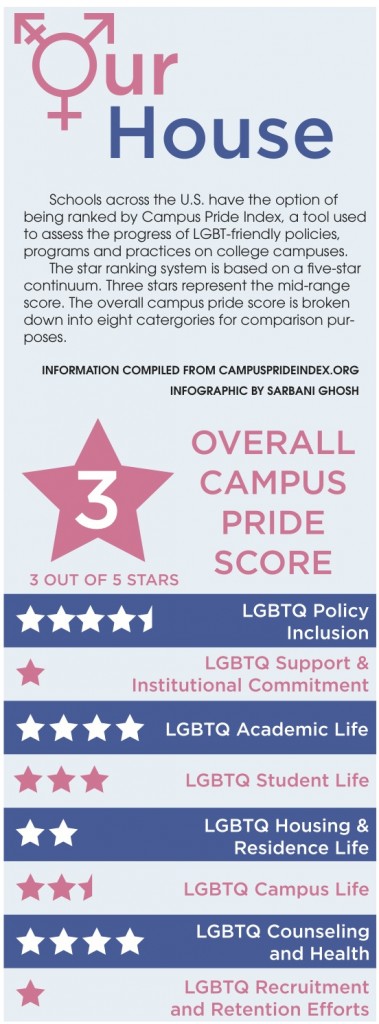
When senior Thomas Iglesias was applying to college, he searched for schools that were lesbian, gay, bisexual and transgender (LGBT) friendly. He chose to attend the University of Miami, he says, despite the lack of services for LGBT students.
“I’m from Miami, so I had the choice about whether or not I wanted to live in the freshmen dorms,” he said. “Looking into it back then, I was completely uncomfortable with the idea of being required to live on a floor of 40 freshmen guys.”
Iglesias, who is also the UPride senator for Student Government (SG), is not alone. In 2013, an LGBT task force was created to evaluate LGBT friendliness on campus, according to Gail Cole-Avent, executive director of student life and assessment. The task force proposes institution-wide initiatives like gender-neutral bathrooms.
As part of this evaluation, the task force sent a spring 2014 campus climate survey to students. The survey revealed that 30 percent of self-identified LGBT students at UM do not feel safe at the university due to their perceived sexual orientation or gender identity. The same survey showed that 35 percent of students have experienced negative or insulting comments because they identified themselves as LGBT.
In 2013, Cole-Avent and task force co-chair Andrew Wiemer, who is also director of the Butler Center for Service and Leadership, got the ball rolling when Patricia Whitely, vice president for student affairs, suggested the task force’s development.
Cole-Avent said that both she and Wiemer assembled a team that represented all sectors of campus – undergraduate students, graduate students, faculty and staff – “with the ultimate goal of developing recommendations for consideration which we would then present to Dr. Whitely and president Shalala [Donna E. Shalala, UM president].”
The first step in that process was to submit a questionnaire for an evaluation from Campus Pride Index, a tool used to assess the progress of LGBT-friendly policies, programs and practices on college campuses.
Results from the 2013 rankings showed that of the top 50 schools in the U.S., the University of Miami ranks lowest in overall LGBT campus friendliness. Cole-Avent has already submitted the 2014 questionnaire and is awaiting the results.
After receiving the Campus Pride assessment, the task force began working on recommendations that would tackle the problem areas within UM’s score, Cole-Avent said.
The Campus Pride score is broken down into eight categories: LGBT policy inclusion, support and institutional commitment, academic life, student life, housing and residence life, campus safety, counseling and health, and recruitment and retention efforts.
Though the university scored high in LGBT counseling and academic life, one of UM’s lowest-scoring areas is housing and residential life. UM scored a two out of five in the category.
According to campusprideindex.com, this score is the result of not offering LGBT housing options, an option for transgender students to be housed with their gender identity or expression, or gender-neutral restrooms in on-campus housing.
Students like Iglesias believe that it is important for first-year students to have the option of gender-neutral housing because some are often intimidated by living on gender-specific floors with others who may not accept them.
“Not every student at UM has the housing option that will make them feel the most comfortable,” he said. “A gender-neutral housing option … would allow LGBTQ students to live and learn in a more inclusive, comfortable and diverse environment.”
Iglesias also mentioned that this option would bring us up to par with the 32 top 50 universities that already offer these services. These top-ranked universities include MIT, Duke University and Ivy League institutions.
James Smart, executive director of housing, says that though there is no gender-neutral housing option, the department has always been willing to accommodate students with special needs.
But Iglesias says that there should be no wait in implementing gender-neutral housing as an option for first-year students. First-year students who opt to live on campus are required to spend at least two semesters in university housing, usually Hecht and Stanford residential colleges, which only offer gender-specific floors.
“This option could be created at no cost for everyone, including freshmen,” he said. “The UV, Mahoney-Pearson and Eaton already have gender-neutral floors. It’s as simple as moving room assignments around for the same amount of people.”
The recently elected SG ticket “For U,” ran with the idea of implementing a gender-neutral housing platform during its term.
Robert Renfro, SG treasurer-elect, says that the university should push for a more inclusive campus environment.
“Gender-neutral has been a conversation of the university for a while,” he said. “But now as students, putting it as a platform on behalf many other students, we have created even more awareness at school on the topic. We have begun the conversation among students, helping them better understand what it means to be a gender-neutral school.”
Renfro also said that this platform would allow the incoming university president to see the importance of being inclusive on this campus.
Similarly, Brianna Hathaway, SG president-elect, said that Whitely was receptive to working with them on these plans.
“We were told gender-neutral bathrooms meaning having more single stall family bathrooms would be a high possibility and feasible and that housing would be something that will take more time,” she said.
Though some of the task force recommendations, like the LGBT mentoring program, have already been implemented, Wiemer says that there is still a lot more to be done.
“Through the campus survey, you saw that there was support here,” he said. “LGBTQ students felt fairly comfortable here, but there were some who did not, you know, there are some populations of the LGBTQ community who do not feel comfortable here, so we have a lot of work to do.”
Interactive infographic by Luke Pukatch. Source: Campus Pride Index
This story has been updated to consistently reflect the correct spelling of Gail Cole-Avent’s last name.






